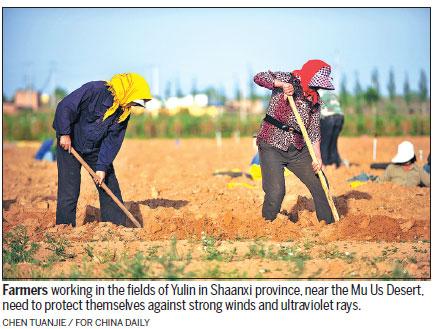The history of economic and social development of northwestern Shaanxi province is also a history of desertification control, according to local experts.
Shaanxi is one of the provinces that face the most serious desertification in China. Yulin, a city in northern Shaanxi bordering the Mu Us Desert, is an important line of defense to stop sandstorms from the northwest moving toward southeastern China.
To prevent desertification, Chifeng, another important city in terms of desertfication control in the Inner Mongolia autonomous region, and Yulin in northwestern China, are the two most important cities, according to the State Forestry Administration.
The desert, with an area of 1.35 million hectares, occupies 99.7 percent of the deserted areas in the province.
In the 100 years before the founding of the People's Republic of China in 1949, the quicksand of Yulin climbed over the Great Wall, expanding 50 kilometers south.
It then devoured about 140,000 hectares of farmland and pasture, said Shi Sheqiang, vice-president of the Desert Control Research Institute of Shaanxi Province.
More than 1 million people in six towns and 421 villages were affected. The green coverage was only 0.9 percent, he said.
"Over-logging, war and bad climate all led to the circumstances," he said.
After years of anti-desertification efforts by the local government, the areas of quicksand were reduced from 146,000 hectares to 3,533 hectares in 2014.
The forestry and grass coverage in the province's desertified area reached about 60 percent in 2014. A large-scale sand prevention belt of up to 2,000 kilometers has been constructed.
The province used to have sandstorms 24 days on average a year. Almost none occurred last year.
The sand-control industry has boosted the related planting, breeding, processing, tourism and new energy industries, Shi added.
The desert now has pilot production bases for red dates, minor grain crops and flat peaches. Other vegetables grown there include green beans and potatoes.
The annual net income of farmers reached 9,730 yuan ($1,499) in 2014 - 27.8 times higher than that of 1993.
There are many role models for desertification control. Additionally, museums and sand arboretums, along with documentaries, were produced to popularize ecological culture.
Shi said the province adopted technological tools to plant trees and grass, including aerial seeding and enclosure to improve efficiency.
Aerial seeding, which utilizes an airplane and processed seeds, can replace human labor to sow seeds in areas that are hard to reach, he said.
It can cover large areas within a short period. For example, one plane can sow seeds in 100 hectares at a time. About 60 percent of quicksand was controlled by using this technique, Shi said.
"We found that middle and late May is the best time for seeding, because the season between spring and summer has sufficient rainfalls."
The province's forestry administration also learned to choose plants with high fertility, and drought and density resistance, he added.
Shi said the challenge is still huge, since there are still more than 426,000 hectares of deserted land waiting to be recovered, along with about 200,000 hectares of dead forest.
"Many of the plants planted before the 1980s are degenerating, weakening their ability to hold back the sand," he said.
"And the plants introduced a few years ago still need time to grow."
For the next stage of the battle against desertification, the province will improve land stability by enhancing management and promoting the transformation of scientific findings, he said.
chenmeiling@chinadaily.com.cn

